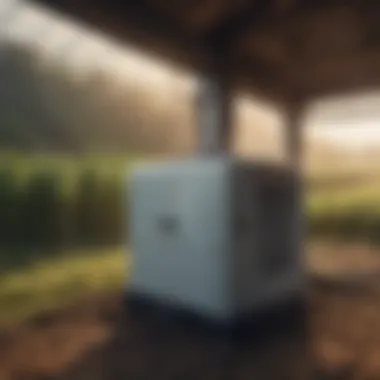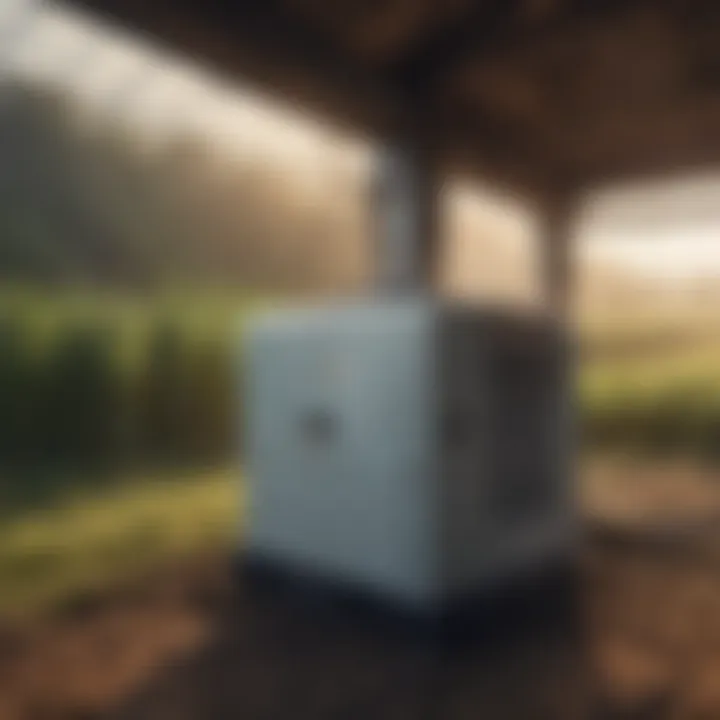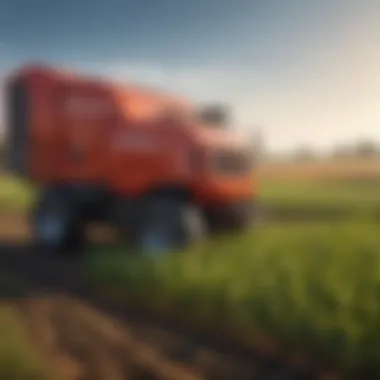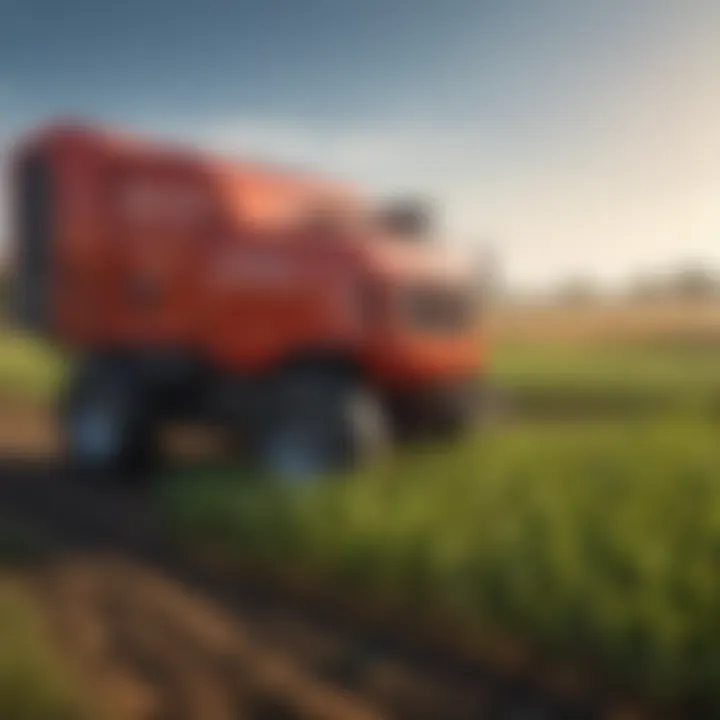Inverter Power Electronics Revolutionizing Agriculture


Intro
In an era where technology intersects with traditional practices, inverter power electronics emerge as a pivotal force in agriculture. Farmers and agricultural enthusiasts are increasingly recognizing the potential of this technology to revolutionize their energy usage. As agricultural operations grapple with rising energy costs and a growing emphasis on sustainability, understanding inverter technology becomes essential.
The integration of renewable energy resources, like solar and wind, is no longer a future consideration; it is a present necessity. Inverters facilitate this transition by converting direct current (DC) from renewable sources into alternating current (AC) used in most electrical devices. The efficiency of these systems directly influences productivity and sustainability in various farming practices.
Understanding Inverter Power Electronics
Inverter power electronics serve as a crucial element in modern agriculture, contributing to energy efficiency and sustainability. Their significance lies in the transformation of direct current (DC) into alternating current (AC), facilitating the integration of renewable energy systems such as solar panels. Understanding inverter technology is essential for farmers and agricultural practitioners who aim to innovate and optimize energy usage in their operations.
Definition and Purpose
Inverters can be defined as electronic devices that convert DC to AC power. This transformation is fundamental for the use of renewable energy sources in agriculture. For instance, solar panels generate DC power, but most agricultural equipment operates on AC power. Thus, inverters serve a vital purpose; they bridge the gap, enabling the seamless use of renewable energy in daily agricultural practices.
- Energy Conversion: Allowing farmers to utilize renewable energy sources effectively.
- Power Regulation: Ensuring that the power supply meets the required specifications for agricultural devices.
- Grid Integration: Facilitating the connection of renewable energy systems to the electricity grid, allowing surplus energy production to be sent back into the grid.
Due to these functionalities, inverters are indispensable in improving energy independence in agricultural operations, reducing reliance on fossil fuels, and promoting sustainability.
Fundamental Principles of Power Electronics
The principles of power electronics are the foundation for understanding how inverters function within agricultural systems. At their core, these principles involve the manipulation of electrical power to convert it into usable formats for various applications. Key elements include:
- Switching Components: Most inverters utilize switching components like transistors and diodes to manage the flow of electricity. These components rapidly switch on and off, controlling the output voltage and frequency.
- Modulation Techniques: To achieve desired output waveforms, modulation techniques such as Pulse Width Modulation (PWM) are employed. These techniques adjust the width of the electrical pulses to create stable and efficient AC outputs.
- Feedback Systems: Modern inverters often incorporate feedback mechanisms to monitor output performance, ensuring power quality and efficiency.
Understanding these principles helps in appreciating the technical aspects behind inverter designs and their effective usage in agriculture. By leveraging these technologies, farmers can not only enhance their operational effectiveness but also play a part in driving the sector towards a more sustainable future.
"Inverter technology is transforming how we approach energy use in agriculture, integrating renewable sources and enhancing sustainability."
In summary, grasping the fundamentals of inverter power electronics is pivotal for any stakeholder in the agricultural sector looking to optimize energy usage and adopt innovative practices. The transition towards renewable energies in farming operations hinges heavily on the capability of inverters to adapt and perform efficiently.
Key Components of Inverter Systems
Inverter systems serve as the backbone of many agricultural technologies that require efficient power management. Understanding the key components of these systems is essential for farmers and agricultural enthusiasts aiming to optimize energy usage and enhance operational efficiency. This section will explore three critical elements of inverter systems: power conversion techniques, control mechanisms, and thermal management systems. Each component plays a significant role in ensuring that inverter technology functions effectively within agricultural applications.
Power Conversion Techniques
At the heart of inverter systems are the power conversion techniques that transform direct current (DC) into alternating current (AC). This conversion process is essential for agricultural machinery that relies on AC for operation.
The following are some common techniques used in power conversion:
- Pulse Width Modulation (PWM): This method manages the power delivered to the load by adjusting the width of the pulses in the output signal. It allows for precise control over the motor speed in tasks such as irrigation.
- Sinusoidal Pulse Width Modulation (SPWM): This technique aims to create a pure sine wave output with reduced harmonic distortion, which is more efficient for many agricultural applications.
- Multilevel Inverters: These inverters produce an output voltage that is a stepped approximation of the desired sinusoidal waveform, improving efficiency and reducing electromagnetic interference.
Farmers benefit from these techniques as they ensure that the energy harnessed from sources like solar panels can be effectively utilized to power agricultural equipment, minimizing losses and improving productivity.
Control Mechanisms
Control mechanisms are vital for the efficient operation of inverter systems. They regulate the performance and ensure the system responds accurately to varying demands in agricultural scenarios. Key elements in the control mechanisms include:
- Feedback Control Systems: These systems monitor the output voltage and current, allowing for real-time adjustments. This is crucial for maintaining optimal performance under different load conditions.
- Microcontrollers: Inverter systems often employ microcontrollers to manage the functions of the inverter. They process signals, execute algorithms, and optimize power delivery based on operational requirements.
- Smart Control Algorithms: As IoT (Internet of Things) integration increases, smart control algorithms adapt inverter operation based on environmental data. Sensors can provide information about soil moisture, weather conditions, and energy availability, allowing for more informed decisions.
Through these control mechanisms, farmers can achieve higher efficiency, reduce waste, and adapt to changing environmental conditions.


Thermal Management Systems
Efficient thermal management is significant in maintaining inverter performance and reliability. Inverters generate heat during operation, and managing this heat is crucial to prevent damage and ensure longevity. Components of thermal management systems include:
- Cooling Fans: These fans help dissipate heat away from critical components, preventing overheating and ensuring optimal performance.
- Heat Sinks: Integrated into designs, heat sinks increase the surface area exposed to air, allowing heat to be effectively released. This minimizes the risk of thermal runaway in power electronics.
- Liquid Cooling Systems: For larger applications, liquid cooling can provide more efficient heat dissipation than air cooling, allowing inverters to operate under high loads without compromising performance.
Effective thermal management not only extends the lifespan of inverter systems but also contributes to their energy efficiency, which is essential for extensive agricultural applications.
Inverter systems are integral in modern agriculture, ensuring energy efficiency, sustainability, and optimum productivity.
In summary, the key components of inverter systems are pivotal to their effectiveness in agriculture. Understanding power conversion techniques, control mechanisms, and thermal management systems allows farmers to choose the right inverter technology that meets their specific needs. As the agricultural sector embraces modern technology, these systems will continue to enhance energy usage and promote sustainable practices.
Solar-Powered Irrigation Systems
Solar-powered irrigation systems utilize inverter technology to convert solar energy into electricity that powers irrigation pumps. This method not only reduces reliance on traditional power sources but also decreases operational costs over time. Solar systems can significantly lower expenses related to electricity bills. Moreover, they empower farmers to manage their water resources more effectively, critical in areas with limited water supply.
In these systems, inverters help to optimize energy usage, ensuring that pumps operate only when needed, which also extends equipment lifespan. By leveraging solar energy, farmers can increase crop yields without elevating their energy costs.
Greenhouses and Controlled Environment Agriculture
In greenhouses, inverter technology plays a key role in maintaining optimal environmental conditions for plant growth. By controlling fans, heating, and cooling systems, inverters ensure that temperatures and humidity levels remain stable. This consistency can lead to higher productivity and better-quality produce.
Inverter systems can also work in tandem with renewable energy sources. For example, by integrating wind or solar energy solutions, greenhouses can lower their carbon footprint. Additionally, the use of automated systems powered by these inverters allows for precise monitoring and adjustments based on real-time data, further enhancing efficiency.
Agricultural Machinery
Inverter power electronics are increasingly found in modern agricultural machinery. Tractors and other equipment equipped with advanced inverter systems can adjust their power output as needed, improving fuel efficiency. This adaptability allows for better performance on uneven terrain or when handling varying loads.
These systems not only contribute to better energy utilization but also lead to a decrease in emissions. With the growing concern for environmental impact, the ability to operate machinery with less energy while maintaining effectiveness is advantageous. Furthermore, this technology reduces maintenance needs, making agricultural operations more streamlined.
Inverter technology in agricultural machinery represents a leap forward in terms of productivity and environmental responsibility.
In summary, the applications of inverter power electronics across various agricultural sectors demonstrate their pivotal role in enhancing energy efficiency. These systems enable farmers to adopt sustainable practices while maximizing productivity, making them indispensable for modern agriculture.
Benefits of Using Inverter Technology
Inverter technology plays a vital role in modern agriculture, offering multiple benefits that can significantly enhance overall farming productivity and sustainability. This section delves into three key areas where inverter technology stands out: enhancing energy efficiency, promoting cost savings, and supporting renewable energy integration. Each of these elements contributes not just to individual farms but also to the agricultural sector as a whole, pushing it towards a more sustainable future.
Enhanced Energy Efficiency
Energy efficiency is a critical concern in agriculture, where energy use can account for a significant portion of operational costs. Inverter technology allows for optimized energy usage in various systems, such as irrigation pumps, ventilation systems in greenhouses, and even heating systems. By utilizing inverters, farmers can better regulate the power output according to their actual needs, avoiding energy waste.
For example, in variable frequency drive (VFD) applications, an inverter adjusts the speed of electric motors based on the demand. This approach not only minimizes energy consumption but also prolongs the lifespan of equipment by reducing wear and tear. Through implementing such technologies, farmers can realize substantial improvements in energy efficiency, which translates directly to reduced utility bills.
Cost Savings and Economic Viability
Integrating inverter technology into agricultural practices can lead to significant cost savings. While the initial investment in inverter systems might be substantial, the long-term savings on energy bills and maintenance costs often justify the expense.
Additionally, modern inverter systems tend to require less upkeep than traditional systems. This reduction in maintenance translates to fewer labor hours and less frequent repairs. Farmers can allocate these resources to other areas of their operations, thus maximizing productivity.
Key factors that contribute to cost savings include:


- Decreased energy costs due to efficient power conversion.
- Lower maintenance expenses due to enhanced system reliability.
- Potential eligibility for government incentives encouraging energy-efficient practices.
Support for Renewable Energy Integration
The agricultural sector is increasingly looking to renewable energy sources due to their sustainability and cost benefits. Inverter technology plays a crucial role in facilitating this transition. For instance, solar-powered systems can effectively use inverters to convert direct current (DC) generated by solar panels into alternating current (AC) that is usable by most agricultural equipment.
Inverters also help in the management of energy flow from renewable sources, allowing farmers to utilize energy when it is available and store excess energy for later use. This shift to renewable energy not only decreases dependency on fossil fuels but also aligns agricultural operations with broader environmental goals.
"Adopting inverter technology allows farms to harness renewable energy effectively, paving the way for a more sustainable agricultural model."
In summary, the benefits of using inverter technology are manifold, encompassing enhanced energy efficiency, economic viability, and support for renewable energy integration. As the agricultural landscape continues to evolve, adopting these technologies will be imperative for farmers who aim to remain competitive and environmentally responsible.
Challenges and Limitations
Technical Limitations
Inverter systems are not without their technical challenges. The performance of inverters can be hindered by various factors such as conversion efficiency and compatibility with existing agricultural equipment. One significant limitation is the power conversion efficiency. Many inverters operate at a less than ideal efficiency rate, resulting in reduced energy output. Moreover, the integration with renewable sources, like solar panels, often introduces complications. Fluctuations in power generation because of variable sunlight can lead to inconsistent supply for agricultural operations.
Additionally, technical malfunctions can occur, which may render the inverter inoperative. Such disruptions can have consequential effects on crucial farming activities, like irrigation and machinery operation. Addressing these technical limitations requires ongoing research and development to improve inverter designs and ensure reliability.
Economic Barriers for Adoption
Adopting inverter power electronics also faces economic barriers that can deter farmers. The initial investment in inverter technology is often substantial. This is especially true for small and medium-sized farms, where budgets are tight. The costs include not just the inverter itself, but also installation and possible upgrades to existing systems. Many farmers are hesitant to embrace this technology due to uncertainties about return on investment.
Moreover, the maintenance costs can add up over time. Inverters require periodic checks and, in some cases, replacement of parts to ensure efficient operation. This could mean further financial strain, especially for those farmers who are already struggling to break even. Educating farmers about long-term savings and the cost benefits of inverter technology is crucial in overcoming these economic hurdles.
Regulatory and Safety Considerations
Regulatory and safety considerations represent another layer of complexity in the adoption of inverter technology. Compliance with local regulations can be cumbersome for farmers. Different regions may have varying standards regarding the installation and operation of inverter systems. Adhering to these laws often requires significant time and resources, which could dissuade farmers from proceeding with implementation.
Additionally, safety concerns surrounding inverters cannot be overlooked. Improper installation or malfunctioning equipment can lead to hazardous situations. The dangers include electrocution risks or equipment failure that can affect farming operations. Thus, ensuring proper training during installation and operation is vital.
"Understanding the trials associated with inverter technology in agriculture is crucial for a smoother transition to sustainable practices."
As the agricultural industry evolves, it becomes paramount to address these challenges head-on. By considering the technical limitations, economic barriers, and regulatory frameworks, the sector can better prepare for the future of inverter power electronics. This comprehensive understanding will pave the way for enhanced efficiency and sustainability in agricultural practices.
Future Trends in Inverter Power Electronics
Understanding the future trends in inverter power electronics is essential as they shape the agricultural landscape. This area is increasingly relevant due to the growing need for energy efficiency and sustainability. Innovations in technology will continue to drive improvements in inverter systems, making them more adaptive and integrated with modern agricultural practices.
Innovations in Power Electronics Design
Recent advancements in the design of power electronics are noteworthy. New semiconductor materials, such as silicon carbide (SiC) and gallium nitride (GaN), offer several advantages. These materials can operate at higher voltages and temperatures, which enhances the overall efficiency of inverter systems.
Key aspects of these innovations include:
- Reduced Size and Weight: New designs allow for more compact systems, making installation and maintenance easier for farmers.
- Increased Reliability: Better materials and designs contribute to more durable systems, resulting in less downtime.
- Improved Thermal Management: Enhanced heat dissipation techniques support higher performance levels and longevity.
These innovations lead to inverters that are more suited to dynamic agricultural environments.
Integration with IoT and Smart Farming


The rise of the Internet of Things (IoT) is transforming the way inverter technologies are utilized in agriculture. Smart farming practices depend on real-time data and automation. Integration of IoT with inverter systems enables:
- Real-time Monitoring: Farmers can track energy production and consumption continuously.
- Automated Control: Systems can adapt operations based on environmental conditions and energy availability.
- Predictive Maintenance: IoT sensors help in identifying potential failures before they occur, reducing maintenance costs.
This integration not only maximizes efficiency but also aligns with precision agriculture strategies.
Sustainability and Eco-Friendly Solutions
The focus on sustainability in agriculture reaches beyond simple efficiency improvements. Inverter technology plays a vital role in promoting eco-friendly practices. Key benefits include:
- Enhanced Renewable Energy Usage: Inverters facilitate the integration of solar and wind energy into farming operations.
- Reduction in Carbon Footprint: By optimizing energy use, inverters help in minimizing the reliance on fossil fuels.
- Waste Reduction: Advanced inverter designs can lead to reduced energy waste, making farm operations more sustainable.
Case Studies: Successful Implementations
The examination of case studies in agricultural applications of inverter power electronics serves as a vital component in understanding how theory translates into practice. These real-world examples underline the practical benefits and innovations that inverter technology brings to various agricultural settings. By analyzing these cases, one can gain insights into the effectiveness of inverter systems, the challenges they overcome, and their contributions to improving farming practices.
Case studies allow farmers and industry stakeholders to see the tangible results of inverter technology. They demonstrate not only the efficiency gains but also the impacts on overall farm productivity and sustainability. Moreover, these studies highlight the challenges faced during implementations and how lessons learned can guide future projects in agriculture.
"Case studies provide concrete evidence of innovation in action. They bridge the gap between theory and practical application, offering valuable insights for future endeavors."
Case Study One: Solar Irrigation Success
Solar-powered irrigation systems stand out as a prominent example of how inverter technology enhances efficiency in agriculture. In a recent project in California, a farming community implemented a solar irrigation system that incorporated advanced inverters. This system allowed for the conversion of solar energy into usable electricity, powering the irrigation pumps without relying on fossil fuels.
The result achieved was significant reduction in operational costs and a notable increase in water efficiency. The inverter's ability to manage varying levels of solar energy ensured that the irrigation system operated optimally throughout the day. This project not only lowered expenses but also contributed to sustainable practices by minimizing carbon emissions.
Case Study Two: Efficiency in Greenhouses
In greenhouses, where environmental control is crucial for crop production, inverter power electronics can dramatically enhance efficiency. In a study conducted in the Netherlands, a state-of-the-art greenhouse utilized inverters to optimize temperature control systems. The system adjusted heating and cooling based on real-time data metrics, which were integrated using inverters that manage power distribution effectively.
This technology resulted in improved yield quality and crop growth rates. Additionally, energy consumption was significantly reduced. The case illustrates how inverter systems can harmonize with environmental factors to optimize resource use in sensitive agricultural operations.
Case Study Three: Transforming Farm Machinery
The agriculture sector has seen substantial advancements in machinery through the adoption of inverter technology. A farm in Australia exemplified this transformation by upgrading its tractors and harvesters with inverters that improved their efficiency. By integrating advanced inverters, the machinery could adapt to varying workloads, leading to better fuel efficiency and reduced wear and tear.
The economic payoff was noticeable with lower maintenance costs and enhanced productivity per acre. Furthermore, this innovation helped farmers align their operations with sustainability goals, showcasing the multifaceted benefits of inverter technology in agricultural contexts.
Epilogue
The conclusion serves as a pivotal element in encapsulating the learnings and insights gathered throughout this article. It is essential to recognize the multifaceted role of inverter power electronics in the agricultural sector and their contribution to sustainable practices. As the agriculture industry evolves, understanding these technologies becomes crucial for farmers and stakeholders alike.
Summary of Key Insights
Inverter power electronics have transformed agricultural practices in several notable ways:
- Enhanced Energy Efficiency: By converting energy more effectively, inverters reduce waste and lower energy costs for farms.
- Support for Renewable Energy Integration: With solar and other renewable sources, inverters play a significant role in making energy usage more sustainable.
- Improved Agricultural Practices: Technologies like solar-powered irrigation and smart farming depend heavily on inverter systems for optimal operation.
These insights are not just theoretical; they represent the practical changes that farmers can implement for better resource management. The beneficial outcomes are clear when considering operational costs, production yields, and environmental impacts.
The Path Forward for Agriculture
As we look ahead, several considerations emerge for the integration of inverter power electronics into the agricultural landscape:
- Adoption of Innovative Technologies: Continuous advancements in inverter designs will ensure greater efficiency and more user-friendly applications.
- Education and Training: Farmers must receive resources and training on using these systems effectively to maximize their benefits.
- Supportive Policies and Incentives: Government policies should aim to support the adoption of renewable energy solutions and technologies in agriculture.
- Collaborations Across Sectors: Partnerships between technology providers, agricultural experts, and educators can pave a smoother path for effective implementation and sustained use of inverter technology.
"Embracing inverter technology not only advances farming but also ensures a more resilient future for agriculture."
Overall, the journey towards integrating inverter power electronics will require dedication, innovation, and collaboration. As these technologies gain traction, their ability to optimize energy use and support sustainable practices will only become more evident.



